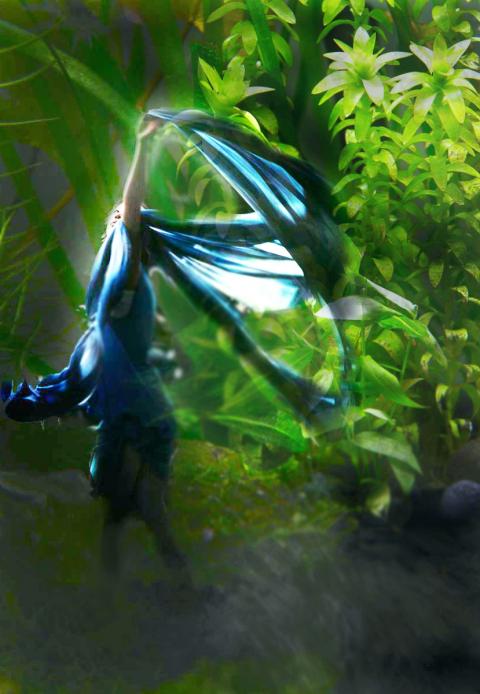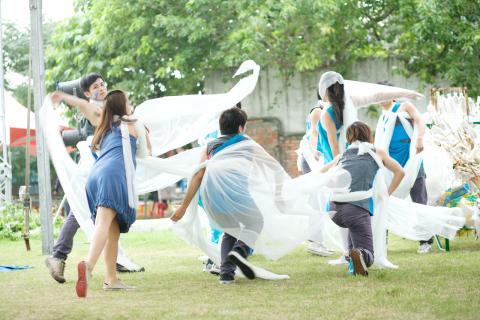Dance and choreography are often described in terms of liquidity or fluidity of movement. This afternoon a group of young Taiwanese dancers will use their bodies to focus attention on the most precious fluid of all — water — and the need for safe drinking water for everyone, as part of a 24-hour worldwide event, Global Water Dances.
The project is the brainchild of 11 Laban Movement analysts who were inspired by a dance and the environment conference they attended in England in 2009. (Labanotation and Laban Movement Analysis were first developed by Rudolf Laban in the early 20th century as a way of describing, notating and recording human movement used by dancers, physical therapists and others.) The 11 all had experience with Laban’s idea of Movement Choirs, which are events aimed at creating social cohesion through community dances. Planning for tomorrow’s event began last year with the creation of a Web site and networking.
Global Water Dances begins in Pacific Rim nations and travels westward around the world, involving dancers, musicians and other artists in 60 cities. It can be followed online at globalwaterdances.org.

Photo Courtesy of Chen Yi-shu, Dancecology
The Taiwanese portion has been organized by a two-year-old troupe called Dancecology (舞蹈生態系創意團隊), founded and directed by Peng Hsiao-yin (彭筱茵), a former member of the Neo-Classical Dance Company (新古典舞團) who received her MFA from the Graduate Institute of Choreography at Taipei National University of the Arts (TNUA). She wanted to move beyond the traditional limits of stage-bound performance to focus on environmental theater, hence the thinking behind the troupe’s name — dance plus ecology, or Dancecology.
Since the group’s founding, it has performed at the 2009 Kuandu Arts Festival, the Taipei Fine Arts Museum, Juming Museum and, earlier this year, at the Taipei International Flora Expo. It was selected as the 2009-2010 artist-in-residence at the TNUA KD Art Culture Industry Innovation Incubation Center. The company joined the Global Water Dances lineup at the end of last year.
Peng’s work is usually site specific and today’s show will take place in the viewing area in front of Zhuwei Wharf (竹圍碼頭) in Tamsui, which is a short walk along the bikeway from the Zhuwei MRT Station (竹圍捷運站). It is also the site of Plum Tree Creek (樹梅坑溪), which was the inspiration for Peng’s portion of the program.

Photo Courtesy of Chen Yi-shu, Dancecology
In her program notes Peng said the creek, a branch of the Tamsui River, was once the only source of fresh water in the Zhuwei area, but rapid development has left it little more than a gutter. Starting last year, several historians, artists and local residents banded together to draw awareness to the creek’s plight and push for its restoration.
Eight dancers and two musicians will be performing this afternoon, joined by children from Zhuwei Elementary School for sections three and four (“The Water Dance” and “Confluence”), which are the global collective portions of the program.
Peng choreographed the first two sections: “Flowing with Water,” which she said will gather the energy of participants and flow along with the Plum Tree Creek, and “The Story of Plum Tree Creek,” telling how humans change and damage nature.
To encourage people to get involved in helping to save the creek and protect Taiwan’s environment, audience members will be invited to join the dancers at several points during the show. For example, when the dancers who are portraying the creek are being polluted by the dancers who are playing the role of garbage, “we’ll invite the audience to save them,” Peng said. In “Confluence,” the troupe’s dancers will lead the audience in a group dance. In “The Water Dance,” dancers and volunteers will perform the same moves that are being danced around the world today.
In addition, after the show audience members will be invited to take a pledge to treasure water resources and reduce daily water pollution. Those who do will be invited to add their handprints to a long roll of paper.
The idea is to turn the paper into a “river of hands,” Peng said.
Dancecology notified us after the paper went to press that because of the advent of Typhoon Meari, their performance will be postponed until next Saturday, July 2, at 5pm at the same location.

In Taiwan there are two economies: the shiny high tech export economy epitomized by Taiwan Semiconductor Manufacturing Co (TSMC, 台積電) and its outsized effect on global supply chains, and the domestic economy, driven by construction and powered by flows of gravel, sand and government contracts. The latter supports the former: we can have an economy without TSMC, but we can’t have one without construction. The labor shortage has heavily impacted public construction in Taiwan. For example, the first phase of the MRT Wanda Line in Taipei, originally slated for next year, has been pushed back to 2027. The government

July 22 to July 28 The Love River’s (愛河) four-decade run as the host of Kaohsiung’s annual dragon boat races came to an abrupt end in 1971 — the once pristine waterway had become too polluted. The 1970 event was infamous for the putrid stench permeating the air, exacerbated by contestants splashing water and sludge onto the shore and even the onlookers. The relocation of the festivities officially marked the “death” of the river, whose condition had rapidly deteriorated during the previous decade. The myriad factories upstream were only partly to blame; as Kaohsiung’s population boomed in the 1960s, all household

Allegations of corruption against three heavyweight politicians from the three major parties are big in the news now. On Wednesday, prosecutors indicted Hsinchu County Commissioner Yang Wen-ke (楊文科) of the Chinese Nationalist Party (KMT), a judgment is expected this week in the case involving Hsinchu Mayor Ann Kao (高虹安) of the Taiwan People’s Party (TPP) and former deputy premier and Taoyuan Mayor Cheng Wen-tsan (鄭文燦) of the Democratic Progressive Party (DPP) is being held incommunicado in prison. Unlike the other two cases, Cheng’s case has generated considerable speculation, rumors, suspicions and conspiracy theories from both the pan-blue and pan-green camps.

Stepping inside Waley Art (水谷藝術) in Taipei’s historic Wanhua District (萬華區) one leaves the motorcycle growl and air-conditioner purr of the street and enters a very different sonic realm. Speakers hiss, machines whir and objects chime from all five floors of the shophouse-turned- contemporary art gallery (including the basement). “It’s a bit of a metaphor, the stacking of gallery floors is like the layering of sounds,” observes Australian conceptual artist Samuel Beilby, whose audio installation HZ & Machinic Paragenesis occupies the ground floor of the gallery space. He’s not wrong. Put ‘em in a Box (我們把它都裝在一個盒子裡), which runs until Aug. 18, invites